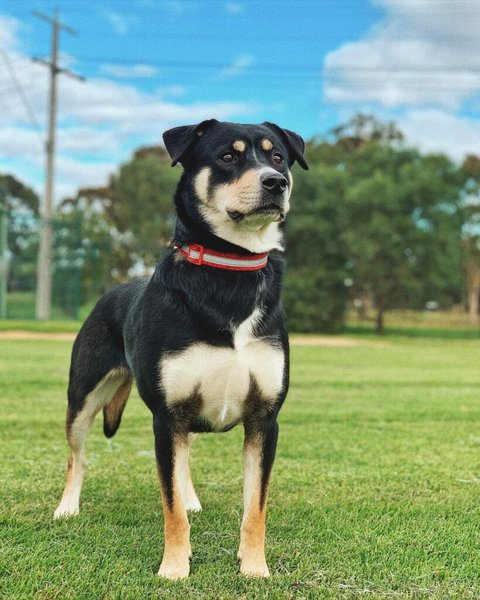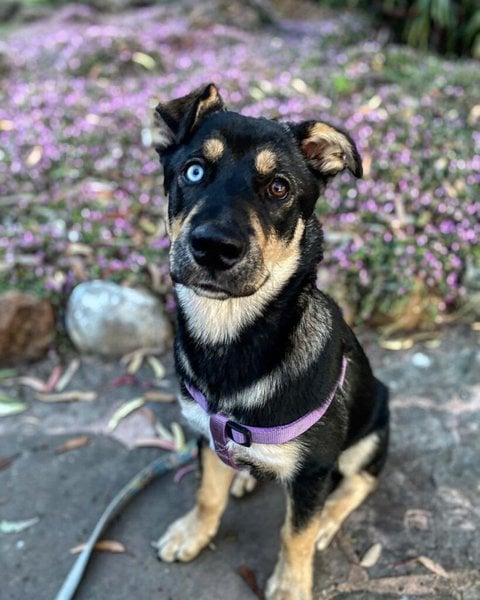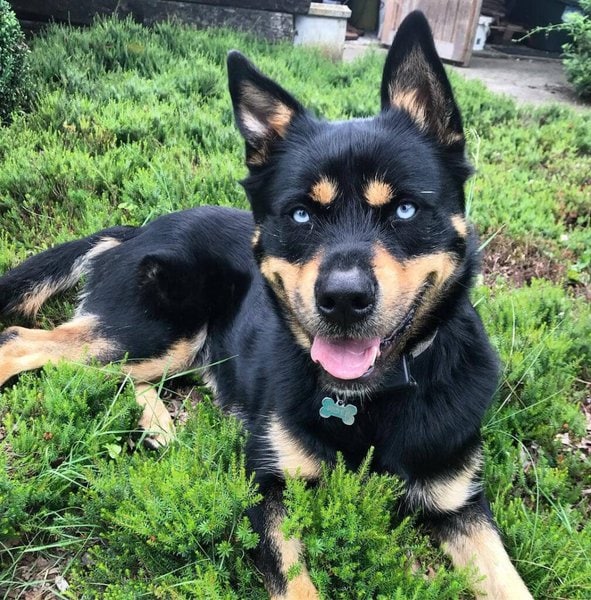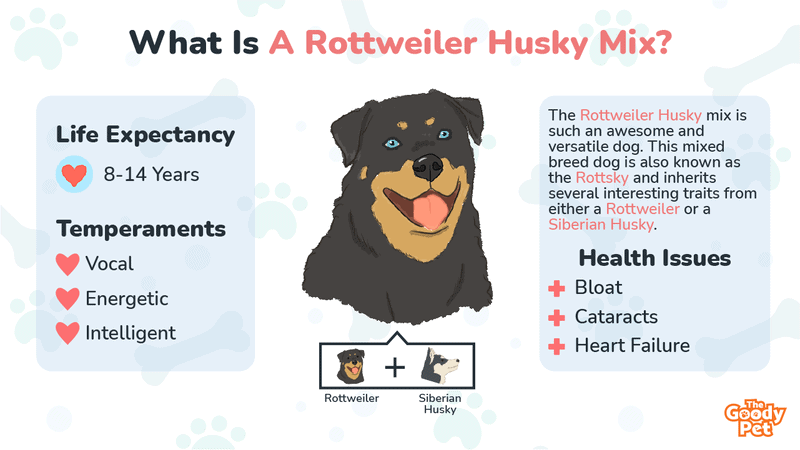Rottweilers and Huskies are two of my personal favorite dog breeds. What makes them so awesome is how versatile they are. If you want a guard dog, then the two can easily be trained for the job. If you want a companion, then both dog breeds are the best friends you could have.
It comes as no surprise that the Rottweiler Husky mix is also such an awesome and versatile dog. This mixed breed dog is also known as the Rottsky and inherits several interesting traits of physique, health, and personality from either a Rottweiler or a Siberian Husky.
If you are considering getting yourself one of these unique and beautiful doggies, here is everything you need to know about them, from what Rottsky’s personalities are like to how to take care of them. But first, let’s take a look at what Rottsky dogs look like and how big they tend to get when fully grown.
How Big Do Rottweiler Husky Mixes Get?
Both Rottweilers and Siberian Huskies are considered to be medium-sized to large dog breeds. The resulting Rottsky mix thus lands in this same category with their size, depending on the size of their parents and genetic dominance.
For some perspective on what you can expect in terms of size and other physical appearance, here is a quick overview of what Rottskies usually look like.
Size And Weight
In terms of size and weight, Rottskies usually measure between 20 to 27 inches in height and 40 to 135 lbs in weight. This makes it a particularly awesome mixed dog breed for dog lovers who prefer a larger yet manageably-sized dog.
Face And Skull Shape
Rottweilers and Huskies have very different facial structures, and the Rottsky can take after any. If they are like their Rotty parent, the mixed doggy will have wider skull and facial features and a shorter snout than that of a Husky.
On the other hand, if they are anything like the Husky, then they will have more of the wolf-like features that purebred Huskies are known for.
Eyes And Ears
If the Rottsky is like the Rottweiler parent, they will usually have short, droopy ears and brown or hazel eyes. They may also have perky ears and lighter-colored eyes with blue or grey shades if the Husky’s genes are stronger.
Coat Type And Color
The coat on a Rottsky is, more often than not, short and smooth. The colors vary greatly and include the classic Rottweiler’s black and tan, as well as the many Husky color varieties, including the iconic Agouti.

How Long Do Husky Rottweilers Live?
Rottweiler Husky mixes have an expected lifespan of about 8 to 14 years. This is what is expected for dogs in their size category and is very similar to the life expectancy of both purebred parents.
For the most part, Rottskies are healthy dogs, as the mixed breeding gets rid of a lot of genetic diseases and issues. However, there are a few common health issues you may encounter, which are important to know about. Here are 4 of the most important of these.
Heart Failure
Heart failure is a common cause of death in Rottskies and is caused by a number of heart conditions. including dilated cardiomyopathy, a complication due to the increased size of the heart due to degenerative muscles, and subaortic stenosis, another complication due to the blood flow restriction caused by narrowing the aortic valve.
Regular vet visits are crucial in these cases for early diagnosis and care management.
Cataracts
Cataracts usually occur in elderly Rottskies and can easily result in total blindness. The condition causes progressive opacification of the lens of one or both eyes. In some rare cases, cataracts may also appear in younger Rottweiler Husky mixed doggies.
Bloat
Large dog breeds with deep chests, like the Rottweiler Husky mix, are likely to develop a condition known as dilation gastric volvulus, which in turn leads to bloat. In these cases, the dog’s stomach twists on itself and expands with air and ingested food.
If not addressed promptly, bloat can be life-threatening for the Rottsky.
Hip And Elbow Dysplasia
Hip and elbow dysplasia are common conditions in both the purebred Husky and Rottweiler dog breeds. Unfortunately, this means that the Rottsky mix is at high risk of developing the same. The joint disease causes instability and severely impacts the dog’s very active lifestyle.

How To Take Care Of Your Rottsky?
Rottskies can be a bit difficult to take care of if you have no idea where to start. Their health issues, as well as size and energy demands require you to come up with a proper strategy to ensure that all their needs are met for a happy and healthy doggy.
If this is your first time round the rodeo, you have come to the right place. Let’s dive right into everything you need to know about taking good care of a Rottsky mixed pooch.
Diet Needs
Rottskies are big dogs with big appetites. They require about 2.5 to 3 cups of dog food as adults and about 1 cup a day while in their puppy stage.
In addition to ensuring they are eating enough, you have to give your Rottsky high-quality and balanced meals. We recommend Pet Plate for this as they make their dog food with the best quality ingredients and vet-recommended recipes for nutritional balance.
Exercise Needs
Your Rottsky should have about 30 minutes to 1 hour of exercise every day. If you choose 30 minutes to work with, you have to make the most of the little time with high intensity workouts that will engage the Rottsky and help keep them fit and healthy.
General Grooming Needs
Good grooming is another integral aspect of taking good care of your Rottsky. Dental hygiene in particular is super important in which case we recommend dental water additives for their convenience and effectiveness.
Other grooming needs your Rottsky will have include daily face and eye wiping, weekly ear washing, and fortnightly nail clipping. We shall take a closer look at coat grooming shortly.
Are Rottskies Good With Kids? Temperaments Of Rottweiler Husky Mixes
Rottskies are good with kids and can be ideal as family pets. Bred from two parent breeds, Rottweilers and Siberian Huskies, Rottskies should display a personality similar to either breeds.
Rotties are known for being very calm, alert, obedient, and brave. Huskies, on the other hand, have a bit more of a lively and goofy personality and are known to sometimes be stubborn.
So which parent does a Rottsky take after? Let’s see.
Intelligent
Both Rottweilers and Huskies are very intelligent dogs which is a trait that they pass down to their Rottsky offspring. This makes Rottsky doggies very easy to potty train and to be taught new tricks and commands.
Independent
Rottskies are very independent dogs which makes them awesome for dog owners with busy schedules. You can very easily leave your dog alone for a few hours while you run errands. Just leave them with plenty of toys and treats to keep them entertained and nourished.
Energetic
Most Rottskies are very much like their lively and somewhat hyperactive Husky parents. These energetic doggies tend to easily get restless, especially if they don’t get enough exercise and attention from you.
Vocal
Rottskies are very opinionated dogs and have no trouble expressing themselves. Rottsky mixes are known not only to bark a lot but also to vocalize through howling and whining on a regular basis. Fortunately, most get calmer and quieter as they grow out of their puppy stage.
Loyal And Protective
Rottsky pooches are some of the most loving and loyal dogs out there. Coming from a Rottweiler background, they are particularly protective of their human families, especially children. This makes them awesome companion pets as well as family dogs.

Do Rottskies Shed A Lot? Grooming Tips For Rottweiler Husky Mixes
Rottskies are not hypoallergenic and in fact shed moderately to heavily.
Hence, proper care of a Rottsky is not complete without a good coat grooming routine. Their beautiful coats are a huge part of what makes them so special, and require extra tender love and care to keep them beautiful.
Fortunately, there is a lot you can do to control the shedding for a healthy Rottsky coat and a clean home for you. Here are the two most important aspects of Rottsky coat care.
Brush 3 Times A Week
Regular brushing is important for Rottskies not only to get rid of loose fur but also to detangle any mats. An interval of 3 times a week should work perfectly for most of the year, but you may have to increase this during spring and fall when their shedding increases.
The right choice of deshedding and detangling tool will also make all the difference, in which case the FURminator Undercoat Tool stands out as the best on the market.
It is not only effective but also very comfortable to use with its ergonomic design and quick-release button for easy cleanup.
Wash Every 6 To 8 Weeks
The second step of good coat care for your Rottsky is regular washing. They can survive on a bath every 6 to 8 weeks as they typically don’t get stinky.
To make sure that the Rottsky’s coat stays beautiful and smells fresh for a long time, we recommend you use a high-quality shampoo like the Mighty Petz 2-In-1 Oatmeal Dog Shampoo And Conditioner. Its soothing properties make it especially great for Rottskies with sensitive skin.
Related Questions
How Much Does A Rottsky Cost? On average, a Rottsky will cost between $500 to $1,000. However, they may cost up to $2,500, especially if Rottweilers from prized bloodlines are used for the mix. For some perspective, purebred Rottweilers cost about $1,500 to $2,500, while pure Husky puppies will set you back between $600 to $1,500.
Can A Husky And Rottweiler Live Together? Huskies and Rottweilers typically get along fairly well. This is largely due to the friendly and tolerant nature of the Husky, but it wouldn’t hurt to conduct some form of socialization training on the Husky too. Rottweilers, on the other hand, require socialization to properly get along with other dogs, especially if the Rotty and the Husky are both males.
Can Rottskies Be Sled Dogs? Rottskies make excellent sled dogs. This is because they are bred from two purebred dogs, Rottweilers and Siberian Huskies, which both have a long history of being used as working dogs with a similar past. Huskies were used to pull sleds on snow, while Rottweilers pulled carts. Whether the Rottsky takes after the Husky or the Rottweiler parent, they will be naturally capable of pulling sleds or carts.





